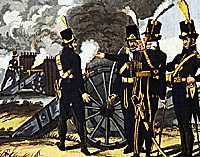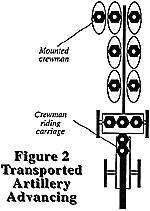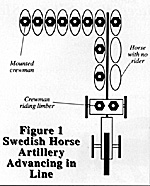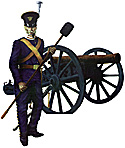The following article is the first of a number of articles on the elements of the Swedish Corps that fought with the Army of the North during the 1813 campaign: horse and transported artillery; jagare (jager) companies; and hussars. Although other Swedish units were available (see chart on page 20), only these three types of formations saw combat against Napoleon's Grande Armee and its allies. Apparently, former French Marshal Bernadotte, now Crown Prince of Sweden, was saving his forces for future action against Norway, a strategy that infuriated his Prussian allies.
 Illustration at right shows Swedish uniforms of 1807 period, courtesy of Anne S. K. Brown Military Collection, Brown University Library.
Illustration at right shows Swedish uniforms of 1807 period, courtesy of Anne S. K. Brown Military Collection, Brown University Library.
"General Cardell advanced with the 1st Horse Battery towards the French artillery until he was at canister range where he unlimbered and opened fire. The heavy barrage was successful and the enemy started to withdraw. After a while the 2nd Horse Battery and the 12-pdr Transported Battery came up and soon all the 20 guns were put into one line of fire.
"Suddenly Cardell became aware of movements by the enemy cavalry which indicated that it was preparing an attack in the artillery's left flank. The 12-pdr battery was immediately ordered to turn up to meet the attack.
"The 12-pdrs were in place just when the squadrons from Nansouty's guard cavalry started their attack. The gunners held their fire until the dense formations were at close canister range. When the troopers spurred their horses for the final charge they were met by the roaring inferno of canister from eight 12-pdrs.
Some of the charges from the heavy guns not only threw back the first line of horsemen but took with them the second and third line as well. The heavy losses forced the French to recall the attack and Cardell could put the 12-pdrs in line with the other guns again and continued the advance towards Leipzig."
This is an extract from an account of the operation of the Swedish horse artillery at the battle of Leipzig, 18 October, 1813. This action at the village of Shanefeld was the last great battle of the autumn campaign of 1813 for the unit. The horse artillery had been the most active element in the Swedish Army and had taken part in the battles at Gross-Beeren, Dennewitz, and Leipzig.
The introduction of horse artillery in the Swedish Army was quite late. In 1792, a young officer, Carl von Cardell, from Stralsund in Swedish Pomerania, produced a pamphlet advocating the introduction of horse artillery into the Swedish Army. Cardell had been experimenting with this type of artillery for a while, and his pamphlet led to his assignment to set up two batteries the same year.
Swedish Horse Artillery: A New Weapon
In 1802 the Swedish artillery was reformed
once again and all foot artillery
was changed to either
transported (akande),
or horse (ridande) artillery
During this period he wrote drill manuals, designed and manufactured lighter guns, and outlined a new organization for the weapon. In the beginning, the two horse batteries were kept outside of the four-regiment organization of the Swedish artillery. The two horse batteries were later incorporated into Wendes Artillery Regiment whose main garrison was Kristianstad in the south of Sweden.
Cardell envisioned the horse artillery as an elite unit and on his initiative it was given the same status as the grenadiers in the infantry. A selection of the best men of the regiment was made for the two horse artillery companies.
Unfortunately, due to continuous lack of financial means, the two horse batteries were reduced to normal foot batteries in 1797.
In 1802 the Swedish artillery was reformed once again and all foot artillery was changed to either transported (akande), or horse (ridande) artillery. The standard type became the transported artillery which was similar to the Austrian "wurst" batteries, with some of the gunners riding on the cannon carriage. At this stage there was only one real horse battery, and that was Cardell's unit at the Wendes Artillery Regiment detachment in Stralsund.
In 1806 a second horse battery was set up for the Pomeranian campaign of 1806-1807 and both units were engaged in several smaller actions. In September 1807 the Swedes were driven out of Pomerania by Marshal Brune, and the Stralsund detachment of the Wendes Regiment was transferred to Kristianstad in the south of Sweden.
Cardell, who by then had advanced to Colonel and commander of Wendes Regiment, continued his work to improve the artillery. However, he could do so with only one of the two horse batteries as they were reduced to a single company due to losses suffered during the retreat from Pomerania.
This was the situation of the Swedish artillery in 1813 when Cardell's artillery returned to Germany to take part in the Leipzig campaign.
1812 Swedish Horse Battery
In 1813 a Swedish horse battery consisted of four 6-pdr cannon ("guns") and two 8-pdr howitzers. The 1st Horse Battery had bronze guns of Cardell's model of 1795. A cannon weighed about 400 kg (1,072 troy pounds) and a howitzer 270 kg (723 troy pounds).
The 120 personnel consisted of 4 officers, 8 NCOs, 108 men. Each battery was also supposed to have 142 horses, caisson teams included.
A horse artillery limber, caisson, and cannon in line formation is shown in figure 1. As a rule, all six guns in the battery would advance in line, that is, side by side instead of one behind another. The purpose was to attempt to hide the artillery from the enemy; in theory, they could not see if it was cavalry or artillery approaching since the guns were hidden behind a line of 48 horsemen. Therefore Cardell insisted that the horse artillery's uniforms would be similar to the cavalry's.
The transported (akande) artillery was the standard field artillery for the Swedish Army during the later Napoleonic era and was gradually introduced 1802-1807. It was a cheaper version of the horse artillery in that fewer horses and men were needed. Since nearly all the horses were part of the limber team and not loose, less training in horse riding was required as well.
The original field organization for a 6-gun battery consisted of 4 officers, 7 NCOs, 100 men, and 103 horses. The standard gun for the transported artillery was the 6-pdr iron cannon from the Helvig 1804 system.
Later, two 8-pdr howitzers were added to the transported batteries, and in 1813 the transported battery was organized in artillery "divisions" of two 8-gun batteries each. These batteries had of course more personnel than the figures given above. There were additional changes made during the campaign that further modified the original organization of transported batteries [see chart on page 20].
Comparisons Between the Two Artillery Types
Little documentation exists that permits a good comparison of the two artillery systems. However, some figures remain which can give us an idea of their performance under ideal conditions.
| Horse Artillery | |
|---|---|
| 1796 | |
| 500 alnar (300m), trotting unlimbering,and firing three ball shots | 1 3/4 minutes |
| 1806 | |
| 500 alnar (300m), walking | 3 minutes |
| 500 alnar (300m), trotting | 1 1/2 minutes |
| 500 alnar (300m), at the double | 3/4 minute |
| Advance 500 alnar (300m), with prolong at the trot | 1 1/2 minutes |
| Retreat 500 alnar (300m), prolong with 1 shot every 100 alm | 2 1/2 minutes |
| Transported Artillery | |
| 1806 | |
| Advance 500 alnar (300m), partly at the trot, partly at the double, unlimbering and firing one shot | 2 minutes |
| Repeat the above maneuver | 2 1/5 minutes |
| Retreat 1000 alnar (600m), unlimbering and firing one shot | 3 minutes |

 Unfortunately, the same exact maneuvers were not done for the two types of artillery, but we can see from the horse artillery figures from 1796 and the first figure for the transported that the horse artillery is a little bit faster.
Unfortunately, the same exact maneuvers were not done for the two types of artillery, but we can see from the horse artillery figures from 1796 and the first figure for the transported that the horse artillery is a little bit faster.
However, one must remember that these tests were probably done at the Wendes training field and therefore do not show the real advantages of the horse artillery, which was better when the ground was rough. Probably the figures would have shown a greater differentiation if the tests had been made over various types of terrain.
Swedish Artillery Uniforms
 In the 1813 campaign, Wendes Regiment wore the uniform model 1808 which was the same for all categories of artillery [uniform plate © 1997 by Magnus Haake at right].
In the 1813 campaign, Wendes Regiment wore the uniform model 1808 which was the same for all categories of artillery [uniform plate © 1997 by Magnus Haake at right].
The men wore a black, shako-like cap (mossa) of felt, nine inches high and wider at the top. Around the top it had a yellow ribbon with a peculiar black fringe and at the bottom was a black leather band. The chin strap was black leather with brass buttons at the side of the cap. The cap plate of brass at the front showed two crossed cannon. At the left side was the company badge and a white plume.
The jacket was dark blue with a single row of brass buttons. The collar was in the regimental color (white for Wendes artillery regiment) with two button holes in yellow lace. The regimental colors of the other Swedish artillery regiments were: blue for Svea, yellow for Gata (Gotha) and red for Finska (the last was disbanded in 1809 after the loss of Finland to Russia). Trousers were long, dark blue with black leather reinforcements and 12 brass buttons on the outer edge up to the knee. Black leather shoes and gaiters. Belts were of yellow leather. NCOs wore the same cap as the men except that a yellow cockard was worn instead of the company badge.
Instead of shoes they had black leather boots with steel spurs. The jacket had golden lace round the button holes at the collar, silver epaulettes and pointed cuffs. A black leather cartridge pouch with a brass plate with the regimental symbol was worn in a yellow belt over the right shoulder.
The officer cap had a golden cord which went round the cap in spiral with a black silk fringe. The guilt cap plate showed the regimental symbol. White plume and cockard to the left. Golden epaulettes. Dark blue trousers with golden lace on the outer seam. Black boots with silver spurs. Black leather cartridge pouch with regimental symbol plate.
The Artillery During the Leipzig Campaign
At the start of the Leipzig campaign the Wendes Regiment units consisted of two "divisions" of transported artillery and one battery of horse artillery. The transported artillery was attached to Sandels's and Posse's Divisions in the Swedish Corps of the Army of the North and the horse artillery was included in the artillery reserve which was commanded by von Cardell.
At Gross-Beeren the Swedish Corps was kept in reserve at the village of Ruhlsdorf. When the battle had gone on for a while Cardell saw that the French were advancing and threatening the Prussian's right flank. He asked the Crown Prince [the former French Marshal Bernadotte] for permission to go to action. After several requests he got the answer: "Eh bien, allez mon ami, si ca vous fait plaisir" ("Well, go ahead my friend, if it makes you happy").
Colonel Cardell advanced with the horse artillery towards the enemy's left wing which seemed to be attempting to envelop the Prussians right flank. When the battery had arrived on the field 2.5 kilometers south of Ruhlsdorf, Cardell spotted a considerable enemy force including a battery of 10 cannon and 4 howitzers.
The Swedish artillery unlimbered at 500 meters from the enemy, so close that some of the Swedish staff thought for a moment that the battery was going to defect! The reason why Cardell advanced so far, however, was that he had seen that the French artillery was less effective at this close range.
The firing started with cannon balls, as round shot was generally considered to be more effective against artillery than case shot. The fire was answered by the enemy, but most of it went far above the Swedish gunners. After a while French skirmishers appeared in a grove on the left flank of the battery and the battery's position became untenable. As the objective to stop the enemy was fulfilled, the battery limbered and returned to the allied lines.
Eventually the French retreat
turned into a rout
Two of the enemy guns had at that stage been totally demolished by the ball fire. Although forced to withdraw, the action had served as the Swedish gunners' baptism of fire, and was considered a qualified success.
After the battle of Gross-Beeren the horse battery was attached to the Cavalry Division of the Swedish Corps.
The night before 6 September the Swedish Army had broken their camp at Rabenstein. At Lobesse it joined the Russian Corps and continued over Feldheim towards Dennewitz.
Lieutenant Johan Tauson, who was in charge of the horse artillery's howitzers, relates that General Adlercreutz of the Crown Prince's staff came riding by when they gave the horses water at a small lake. He ordered von Muhlenfels who commanded the horse-artillery to follow him together with the battery. They trotted for five kilometers to the village of Wolmsdorf where they were put under the Prussian General Borstell.
The Prussian's right wing was under hard pressure from French artillery. The Swedish battery immediately was sent into the fight, and was supported by a Russian and a Prussian battery which were put in line with the Swedish guns at the village of Galsdorf. At first their fire was hindered by Prussian infantry which came running in disorder to take cover behind the allied guns. But after a short while, the fire from the combined batteries made it possible for the Prussian battalions to rally and renew their attack against the village.
The French were eventually thrown out, but some of their artillery was still intact and fighting; the Prussians in the village received heavy fire. Now von Cardell arrived with the transported 6-pdr battery from the artillery reserve and joined the allied batteries. Their combined fire soon silenced the French artillery. The enemy started to retreat, closely followed by Cardell and the other batteries which put the French artillery under heavy barrage every time it tried to take up a new position. Eventually the French retreat turned into a rout, and the allied victory was complete.
Prussian Praise
The Prussian commanders, who had not been on good terms with the Swedes and their Crown Prince during the campaign, praised the conduct of von Cardell and von Muhlenfels. Prussian General von Bulow stated in his report: "This artillery under these outstanding officers' leadership fought with utmost bravery and to a large degree contributed to the brilliant result of this day. All that could be expected by the bravest of troops have been done by this artillery."
The Crown Prince was very impressed by the performance of the horse battery at Dennewitz and after the battle Cardell (who had been promoted to Major-General) was given the task to set up a second horse artillery battery for the Swedish Corps of the Army of the North.
The personnel for this new horse battery were taken from Wendes Regiment which also took over the transported 12-pdr battery. At the time of the battle of Leipzig Cardell's artillery reserve consisted of two six-pounder horse batteries and one transported twelve-pounder battery, all with personnel from his own regiment.
At Leipzig the Army of the North arrived first on 18 October and while the rest of the Swedish Army was kept in reserve, the artillery was ordered by the Crown Prince to give support to St.-Priest's 8th Russian Corps. Cardell rode with the artillery reserve from Plausig and crossed a small river at the village of Plasen. He arrived at Schanefeld where St.-Priest's corps was heavily engaged by an enemy force strong in artillery. The Russians had no guns to counter the French artillery fire, and as soon as Cardell arrived with the 1st Horse Battery he closed to canister range and pressed back the enemy battery. The Russian infantry renewed their attack with a spirited "Urrah" while the two other batteries came up and joined the first.
Cardell received orders from St.-Priest to advance towards Leipzig with his 20 guns and was promised support from the Russian corps. However, it seems that Cardell's guns were alone on the field when the French launched the cavalry attack which is described in the beginning of this article. Leipzig was the hardest action ever for all of the officers. Most damage was caused by the enemy howitzers that blew two Swedish ammunition caissons into the air together with several men and horses.
The losses of the Wendes Regiment on 18 October were so heavy that Cardell asked Field Marshal Stedingk, commander of the Swedish Corps, to spare it when attacks were renewed the next day. So it was the Gata (Gotha) Artillery Regiment which gave support to the Swedish jagare battalions which stormed through the Grimma-Gate into Leipzig on 19 October.
The performance of the Wendes Regiment in 1813, and especially its horse battery, resulted in it being awarded a standard of honor by the Swedish King on 7 July, 1815. The banner included the names of the three victories of Gross-Beeren, Dennewitz and Leipzig. Wendes Regiment is the only Swedish unit which has any major Napoleonic battle on its regimental banner.
More Swedish Artillery:
-
Swedish Army at Leipzig OOB (graphics--very slow: 200K)
Swedish Army at Leipzig OOB (text: fast)
Large Map: Battle of Leipzig, Swedish Deployment (very slow: 153K)
Jumbo Map: Battle of Leipzig, Swedish Deployment (very slow: 337K)
Related:
-
Prelude to Leipzig, Battle of Liebertwolkwitz
Swedish Horse Artillery and the 1813 Campaign
Swedish Jagers and the Storming of Leipzig
Swedish Mornerska Hussars
Next issue we continue this series with the jagare companies.
Sources
Hedberg, Jonas. Kungliga Artilleriet - Det Ridande Artilleriet. Militarhistoriska Farlaget Uddevalla 1987.
Kindberg, Axel. Anteckningar om Varmlands Faltjagare. Stockholm 1918.
Ossian-nilsson. Wendes regementes historia 1794-1944. Kristianstad 1944.
Tingsten, Lars. Sveriges Krig och Yttre Politik 1812-1814. Stockholm 1915.
Wendes Regemente 1813. Gateborg 1913. (no author or editor)
About the Author:
Gustav P. Bergman lives in Sweden and works for the Swedish phone company, Telia. He has a M.S. in Engineering Physics from Lund University. A history researcher for ten years and avid Napoleonic student, he has been published in various newspapers and magazines.
Back to Table of Contents -- Napoleon #8
Back to Napoleon List of Issues
Back to MagWeb Master Magazine List
© Copyright 1997 by Emperor's Press.
This article appears in MagWeb (Magazine Web) on the Internet World Wide Web.
The full text and graphics from other military history magazines and gaming magazines are available at http://www.magweb.com